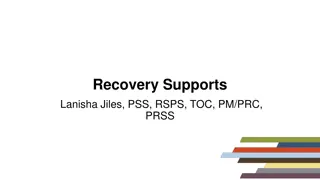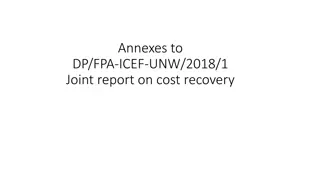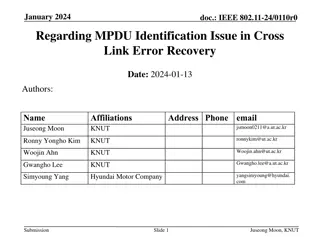
Unusual Attitude Recovery in Private Pilot Training
Explore the importance of recovering from unusual flight attitudes in private pilot training, including the reasons behind unusual attitudes, recognition techniques, recovery procedures, and real-life examples. Learn why it's crucial to swiftly and effectively handle unexpected aircraft attitudes to ensure safety in flight.
Download Presentation

Please find below an Image/Link to download the presentation.
The content on the website is provided AS IS for your information and personal use only. It may not be sold, licensed, or shared on other websites without obtaining consent from the author. If you encounter any issues during the download, it is possible that the publisher has removed the file from their server.
You are allowed to download the files provided on this website for personal or commercial use, subject to the condition that they are used lawfully. All files are the property of their respective owners.
The content on the website is provided AS IS for your information and personal use only. It may not be sold, licensed, or shared on other websites without obtaining consent from the author.
E N D
Presentation Transcript
Unusual Attitude Recovery Private Pilot Curriculum Stephen Saslow August 2020
Objective The student should develop knowledge of the elements related to recovering from unusual flight attitudes as required in the ACS/PTS. The student will understand the reasons unusual flight attitudes may occur and the proper recovery procedure for a nose low or nose high unusual flight attitude
Elements of Unusual Attitudes General Unusual Attitude Situations and Conditions Recognizing Unusual Attitudes Recovery Basics Nose High (Climbing Turn) Recovery Nose Low (Diving Spiral) Recovery Coordination During Recovery
What are Unusual Attitudes, Why Do We Learn Recovery From Them? An unusual attitude is an airplane attitude not normally required or desired for instrument or visual flight An uncorrected unusual attitude can result in a dangerous situation if not recovered properly and quickly
Possible Situations of Unusual Attitude Recovery On July 16, 1999, JFK Jr. was killed along with his wife and sister-in-law, when the aircraft he was piloting crashed into the Atlantic Ocean. Kennedy had 310 hours of flight experience, including 55 hours of night flying and 36 hours in the high-performance Piper Saratoga. He had completed about half of an instrument training course. The NTSB investigation found no evidence of mechanical malfunction and determined that the probable cause was "the pilot's failure to maintain control of the airplane during a descent over water at night, which was a result of spatial disorientation (or, not recovering properly from an unusual attitude). Factors in the accident were haze, and the dark night."
Since unusual attitudes (UAs) are not intentional maneuvers, they are often unexpected The reaction is therefore, instinctive rather than intelligent and deliberate Individuals usually react with abrupt muscular effort, which is purposeless and even hazardous in turbulent conditions, at excessive speeds, or at low altitudes When an unusual attitude is noticed on your crosscheck, the immediate problem is not how it got there, but what is the aircraft doing and how to get it back to straight and level flight as quickly as possible Recognizing Unusual Attitudes
Possible Situations of Unusual Attitudes Without adequate visual references, a pilot may unintentionally allow the aircraft enter an Unusual Attitude Turbulence Preoccupation with cockpit duties Disorientation Carelessness in crosschecking Instrument Failure Errors in instrument interpretation Confusion Lack of proficiency in aircraft control
General Rule: If you note an instrument rate of movement or indication other than those you associate with the basic instrument flight maneuvers already learned, assume an unusual attitude and increase the speed of crosscheck to confirm the attitude, or instrument error, or instrument malfunction When an unusual attitude is noticed on your crosscheck, the immediate problem is not how it got there, but what is the aircraft doing and how to get it back to straight and level flight as quickly as possible To avoid aggravating the UA with incorrect controls, the initial instrument reading must be accurate Recognizing Unusual Attitudes
Nose High Attitudes (Climbing Turn) Shown by the rate/direction of movement of the altimeter, VSI, and airspeed indicator as well as the attitude indicator indications Rapidly decreasing airspeed Rapidly increasing altitude (or increasing faster than desired) The turn coordinator indicates a bank Nose Low Attitudes (Diving Spiral) Shown by the same instruments but in the opposite directions Rapidly increasing airspeed Rapidly decreasing altitude (or decreasing faster than desired) The turn coordinator indicates a bank Recognizing Unusual Attitudes
Common Errors This error is due to poor instrument crosscheck and interpretation Once in an unusual attitude, determine how to get out, not how the airplane got there Unusually loud or soft engine and wind noise may provide an indication Recognizing Unusual Attitudes
Recovery Basics Recovery Basics In moderate unusual attitudes, the pilot can normally reorient with the attitude indicator, but this should not be done: If the attitude indicator is spillable, its upset limits may have been exceeded It may have become inoperative due to mechanical malfunction Even if it isn t spillable and is operating properly, errors of up to 5 degrees pitch and bank may result Indications are difficult to interpret in extreme attitudes Recovery, instead, is initiated by reference to the airspeed indicator, altimeter, VSI, and turn coordinator Common Error - Consequences of attempting to recover from an unusual flight attitude by feel rather than by instrument indications The most hazardous illusions leading to spatial disorientation are created by the information received in the inner ear The motion system in the inner ear can be tricked, and produce false sensations You must believe and interpret the flight instruments since spatial disorientation is normal in UA
Unusual Attitude Recovery Nose High (Climbing Turn) Recovery Nose High Attitudes (Main Point: Avoid a stall) - If the airspeed is decreasing, or below that desired: Increase power Power is increased to arrest the decreasing airspeed Apply forward elevator pressure to lower the nose Forward elevator reduces the AOA, assisting in preventing a stall Correct bank by applying coordinated aileron and rudder pressure by reference to the turn coordinator Aileron pressure before reducing the AOA could result in a spin The steps listed are made in the order described but almost simultaneously Common Error - Inappropriate control applications during recovery Accurately interpret the instrument indications before starting a recovery Follow the recovery steps in sequence Control movements may be large but they must be smooth, positive, prompt, and coordinated
Unusual Attitude Recovery Nose High (Climbing Turn) Recovery After initial control has been applied, continue with a fast crosscheck to ensure proper corrections Level Flight is indicated by: Reversal and stabilization of the Altimeter and airspeed indicator Straight and Coordinated Flight is indicated by: Level miniature aircraft and centered ball on the turn coordinator Common Error - Failure to recognize from instrument indications when the airplane is passing through a level flight attitude With an operative attitude indicator, level flight exists when the miniature airplane is level with the horizon Without the attitude indicator, level flight is indicated by the reversal and stabilization of the airspeed indicator and altimeter
Unusual Attitude Recovery Nose Low (Diving Spiral) Recovery Nose Low Attitudes (Main Point: Avoid over G-ing the aircraft) - If the airspeed is increasing, or above that desired: Decrease power to idle Level the Wings Correct the bank attitude with coordinated aileron and rudder pressure by reference to the turn coordinator Raise the nose to level flight attitude by applying smooth back- elevator pressure Increasing pitch attitude without decreasing bank will result in excessive G s on the airplane The instinctive reaction is to pull back on the controls Removing bank decreases the amount of force required to return to level flight Raise the nose smoothly to avoid overstressing the airplane The pressures listed should be made in the sequence given Common Error - Inappropriate control applications during recovery Accurately interpret the instrument indications before starting a recovery Follow the recovery steps in sequence Control movements may be large but they must be smooth, positive, prompt, and coordinated
Unusual Attitude Recovery Nose Low (Diving Spiral) Recovery After initial control has been applied, continue with a fast crosscheck to ensure proper corrections Level Flight is indicated by the altimeter and airspeed indicator needles stopping and reversing direction When airspeed returns to normal, set cruise power Common Error - Failure to recognize from instrument indications when passing through level flight With an operative attitude indicator, level flight exists when the miniature airplane is level with the horizon Without the attitude indicator, level flight is indicated by the reversal and stabilization of the airspeed indicator and altimeter
Unusual Attitude Recovery Coordination During Recovery The attitude indicator and turn coordinator should be checked to determine straight/coordinated flight (wings level, ball centered) Skidding and slipping sensations can easily aggravate disorientation and retard recovery A nose low recovery could result in excessive G s and uncoordinated flight, causing big problems
Unusual Attitudes and the Senses Hearing Visually Feel Listen for the sound of the air around the airplane. Increasing noise indicates increasing airspeed. Decreasing noise indicates decreasing airspeed Listen to the sound of the engine. Increasing engine noise indicates increasing engine speed; decreasing noise means decreasing airspeed Nose high or nose low attitude of the airplane in in VMC If IMC, no outside references available Control pressures may change, especially as the airplane gets slow and approaches a stall Your inner feel is not to be trusted your inner ear will play tricks on your brain Increasing G load could indicate a spiral
Unusual Attitude Recovery Objective: The student should develop knowledge of the elements related to recovering from unusual flight attitudes as required in the ACS/PTS. The student will understand the reasons unusual flight attitudes may occur and the proper recovery procedure for a nose low or nose high unusual flight attitude. Purpose: An uncorrected unusual attitude can result in a dangerous situation if not recovered properly and quickly. Private Pilot ACS Skills Standards Recognize unusual flight attitudes; perform the correct, coordinated, and smooth flight control application to resolve unusual pitch and bank attitudes while staying within the airplane s limitations and flight parameters.
Common Common Errors Errors Failure to recognize an unusual flight attitude Consequences of attempting to recover from an unusual flight attitude by feel rather than by instrument indications Inappropriate control applications during recovery Failure to recognize from instrument indications when the airplane is passing through a level flight attitude
Unusual Attitudes: Conclusion When recovering from an unusual attitude, it is essential to ignore the attitude indicator and use the airspeed indicator, altimeter, turn coordinator, heading indicator and VSI to determine the attitude of the aircraft. Recovery should be made promptly in the proper order to avoid damaging the airplane or inducing a stall. Once level flight has been attained, the airplane should be reconfigured for straight-and-level flight.






















